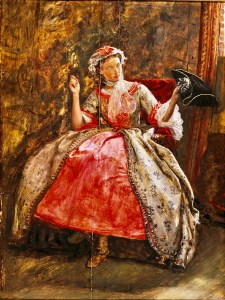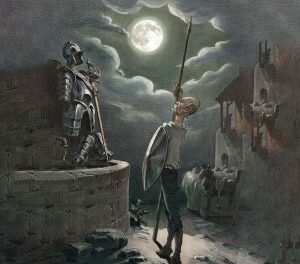We support our Publishers and Content Creators. You can view this story on their website by CLICKING HERE.
Like their British counterparts, the American Jacobites bitterly criticized the damage done to the working class and cities by the industrial system and listening to their neo-feudal critiques one sees similarities with Progressivism and Populism. While these latter movements analyzed from the perspective of the political left, the Jacobites did so from the political right. America needed less democracy, not more, and a liberty rightly understood as the pursuit of the good and true.
Jacobitism in Britain and the United States, 1880–1910, by Michael J. Connolly (184 pages, McGill-Queen’s University Press, 2023)
Editor’s Note: This essay is based on the present book, which is 30% off with the code MQSP through June 30, 2023 at the McGill-Queens University Press website.
In January 1897 at the Church of the Evangelist in Philadelphia, American Episcopalians gathered to celebrate the life of King Charles I and unveil a massive specially commissioned portrait of the martyred king which hung just below the church’s rose window. Bishop Wallace Stevens Perry of Iowa officiated and declared in his homily that King Charles was as much an American founding father as any of the famous Virginians. The royal charters he granted, as well as those of the other Stuart kings, created what would become the United States and all Americans should be grateful to the king for his beneficence, even New Englanders whose Puritan ancestors battled royal prerogative and backed Oliver Cromwell. Upon hearing of Perry’s assertions, the establishment press blew up. Anyone lauding King Charles was un-American and guilty of “reactionary tendencies.” The Republican New York Tribune thundered, “It was the most amazing recrudescence of a lost cause and of false idols to be recorded in these last years of the nineteenth century.”
This celebration of King Charles I came amidst a Jacobite revival between the 1880s and World War One in both Great Britain and the United States. In Britain, Victorian Jacobites venerated Stuart monuments, led solemn prayers on battlefields and held masses to fallen kings, founded Jacobite societies like the Order of the White Rose (OWR), and launched new magazines the purpose of which was to reconceptualize British history. No longer would the events of 1688 be described as a “Glorious Revolution,” but instead the overthrow of a legitimate king and the detouring of British life into a nightmare of industrial strife, urban misery, the destruction of the countryside, an economy of getting and spending, and a degraded culture more concerned with “doing as one likes” rather than the discovery of beauty.
It began with the founding of the OWR in 1886 by the Legitimist Lord Ashburnham and the Cornish nationalist Henry Jenner. A Jacobite society dedicated to the restoration of legitimate royal authority in Britain and across Europe, the Order confined itself to intellectual pursuits at first and members read essays and delivered lectures on British history at its monthly meetings in London over dinner and claret. Members came primarily from three groups: the aristocracy, Anglo-Catholic and Roman Catholic clerics, and artists from diverse fields like painting, sculpture, and literature who saw in Jacobitism a reflection of the prevalent Romanticism. These early years were all very proper and refined.
 By the 1890s, growing frustration at parliamentary corruption and conditions of late Victorian life led many Jacobites to abandon a life of the mind for political activism, running for office, and public protest. Stuart statues were decorated with flowers and wreathes – including sashes with prayers and messages suggesting Queen Victoria was not the legitimate monarch – leading to prominent disputes with London authorities. They also advocated openly for the return of the Stuarts once Queen Victorian died. Following Stuart lineage, the legitimate Queen of England was really Queen Mary of Bavaria and her son Prince Rupprecht the legitimate heir, and these Jacobites eagerly communicated with the both them. Matters came to a head in 1892, when a group of several hundred Jacobites entered Westminster Abbey with bouquets for the tomb of Mary, Queen of Scots. Cathedral authorities refused to allow them access and the group was nearly arrested for making threatening complaints.
By the 1890s, growing frustration at parliamentary corruption and conditions of late Victorian life led many Jacobites to abandon a life of the mind for political activism, running for office, and public protest. Stuart statues were decorated with flowers and wreathes – including sashes with prayers and messages suggesting Queen Victoria was not the legitimate monarch – leading to prominent disputes with London authorities. They also advocated openly for the return of the Stuarts once Queen Victorian died. Following Stuart lineage, the legitimate Queen of England was really Queen Mary of Bavaria and her son Prince Rupprecht the legitimate heir, and these Jacobites eagerly communicated with the both them. Matters came to a head in 1892, when a group of several hundred Jacobites entered Westminster Abbey with bouquets for the tomb of Mary, Queen of Scots. Cathedral authorities refused to allow them access and the group was nearly arrested for making threatening complaints.
What is fascinating about these Jacobites (sometimes called neo-Jacobites), unlike their eighteenth-century forerunners, is that they used their movement to offer a broader critique of late Victorian life, not just press for the return of a legitimate sovereign. In their essays and public speeches, they presented a comprehensive analysis of British political, economic, and cultural life. Democracy was rule by the worst, monarchical power needed reinvigoration to thwart parliamentary radicalism and venality, and industrial and finance capitalism harmed workers, destroyed the living environment of British cities, and stripped the countryside of its resources and population to feed the needs of the market revolution. Their considerations were not flippant asides built upon “status anxiety,” but remarkably insightful critiques of a world gone tragically wrong drawing from thinkers like Robert Filmer and Thomas Hobbes. As one Jacobite wrote, socialists are not the real revolutionaries, as they merely reflect the Victorian zeitgeist. Instead, “the Radical of the moment is really the High Tory.”
These British Jacobites commented widely on world events too, facing considerable public scorn for airing their views. They had divided opinions on the United States, at once a “mushroom republic” filled with money-hunting and celebrity-craving narcissists but also a useful counter to the liberal usurping Spanish dynasty. They hoped the Spanish-American War would lead to a Carlist revival and Ashburnham even engaged in gun-running to bolster the Carlist cause. These Jacobites also stoutly opposed the Boer War, seeing Paul Kruger and his rebels in the tradition of Bonnie Prince Charlie and the good fight of 1745.
The Jacobite movement crossed the Atlantic by the 1890s, finding a comfortable home in the United States and Canada. Led by the likes of the New England neo-Gothic architect Ralph Adams Cram and the Canadian Anglican priest Robert Thomas Nichol, the American Jacobites opened branches of the OWR and the Society of King Charles the Martyr, held masses for the late king in Boston and New York, organized events for “Royal Oak Day,” and even published their own magazine called the Royal Standard. Like their British counterparts, the American Jacobites bitterly criticized the damage done to the working class and cities by the industrial system and listening to their neo-feudal critiques one sees similarities with Progressivism and Populism. While these latter movements analyzed from the perspective of the political left, the Jacobites did so from the political right. America needed less democracy, not more, and a liberty rightly understood as the pursuit of the good and true.
Advocating a king for the United States was heavy-going in the 1890s, so instead Cram adapted Jacobite philosophy to the New World. He came from an old New England Federalist family – “Ralph” as in Ralph Waldo Emerson and “Adams” as in John and John Quincy Adams – and greatly admired Alexander Hamilton’s vision of a monarchical presidency. If America could not have a king or queen, then perhaps an elected monarchy with longer terms of office and an absolute veto would do. Add a more permanent Senate and soon the US would have English-style governance to counteract a corrupt congressional system dominated by oligarchs.
When the “Mauve Decade” passed, Jacobitism ended with it. In Great Britain, the movement receded slowly until World War One delivered the killing blow. Prince Rupprecht of Bavaria, the legitimate heir to the British throne, commanded a sector of the Western Front that faced British troops in the opposite trenches who were technically his own subjects. Advocating Jacobitism in these circumstances was rather difficult. In North America, Jacobitism died more quickly. Cram’s affection for King Charles I hurt his architectural career, as potential clients blinked at hiring Boston’s best-known Jacobite. Father Nichol, the heart of the New York City Jacobite movement, converted to Roman Catholicism in 1899 and left the priesthood, eventually working at the Metropolitan Museum of Art. Without its primary spokesmen, American Jacobitism slipped away by 1905.
Why care about Victorian Anglo-American Jacobites, when their total numbers likely never crested more than two or three thousand members? First, the Jacobites on both sides of the Atlantic were members of the religious and cultural elite of their day: a Boston architect, an Anglican vicar, a British peer, a museum director, a renowned genealogist, a Scottish quarry heiress. These men and women understood that political and cultural reformations are directed by elites, not by masses of protestors and voters. Even the most egalitarian and leveling enterprises are led by minds greater than the mass. Gilded Age elites were corrupt and self-interested and the Jacobites meant to find virtuous replacements.
Second, American conservatives have never fully appreciated the power of historiography and are only now, in the face of the 1619 Project and public education battles, awakening to its importance. These Victorian Jacobites well understood historiography’s importance, as the Whig historical narrative created since 1688 sanctified not only the post-Stuart monarchy but the liberal values ushered in by the “Glorious Revolution.” Inculcated in the new liberalism, generation after generation of British citizens lived amidst liberal presuppositions, so much so that to challenge those assumptions was seen as unpatriotic. It is telling that the first business of the Order of the White Rose was publishing historical essays to reframe British history. The same dynamic occurred in the United States, as the Jacobites discovered in the wake of the Philadelphia portrait ceremony. “Is the Episcopal Church really going to approve of King Charles and what he stood for, thus ceasing to be American in its sympathies?” the New York Tribune asked.
When you lose control of the historical narrative, you surrender the understanding of the past to your opponent’s vision. Their interpretation and its precedents legitimate a range of policies and projects. If the American historical narrative of liberty is the liberation from constraint and equality one of “equity” and equal results, then public policy prescriptions (and the social pressure to conform that accompanies them) will follow suit and lean upon that history to legitimate it. As I have written elsewhere in these pages, historiography lends legitimacy. Challenges from outside the official narrative are thereafter the works of un-American cranks and misfits. No amount of winning elections will change this. If you surrender the telling of history and the educational system that institutionalizes it to those of the opposite persuasion, you operate without legitimacy and the necessary precedents for action. Put simply, people will not imagine the world any other way than as it is.
Third, the Victorian Jacobites are another example of how the historian Louis Hartz was wrong. In 1955, Hartz wrote in The Liberal Tradition in America that the United States had always been a classically liberal nation. The Liberal Left erred toward state solutions to political and economic problems, while the Liberal Right leaned toward market remedies. Neither, however, denied the liberal underpinnings to the American project – a natural rights regime, the progressive liberation from constraint, and a property-based possessive individualism. This omnipresent liberalism marked the US as fundamentally different from Europe with its mainstream socialist parties and social order-based traditionalism.
Hartz, of course, wrote Liberal Tradition as a lament – that liberalism prevented European-style socialism in America – and left-wing historians since then have worked assiduously (and quite successfully) to prove him wrong. Victorian Jacobitism demonstrates his error about traditionalism, as well. A traditionalist anti-liberalism has always existed in American history (in its most useful form an inheritance from New England), from Fisher Ames to Richard Henry Dana, Sr. to Barrett Wendell to Henry Adams, offering a sustained critique of liberalism and the liberationist impulse. Ralph Adams Cram and the Jacobites fit squarely in this tradition and offer inspiration to those searching for precedents.
This essay was first published here in March 2023.
The Imaginative Conservative applies the principle of appreciation to the discussion of culture and politics—we approach dialogue with magnanimity rather than with mere civility. Will you help us remain a refreshing oasis in the increasingly contentious arena of modern discourse? Please consider donating now.
The featured image is “The White Cockade” (1862) by John Everett Millais, and is in the public domain, courtesy of Wikimedia Commons.

 Conservative
Conservative  Search
Search Trending
Trending Current News
Current News 





